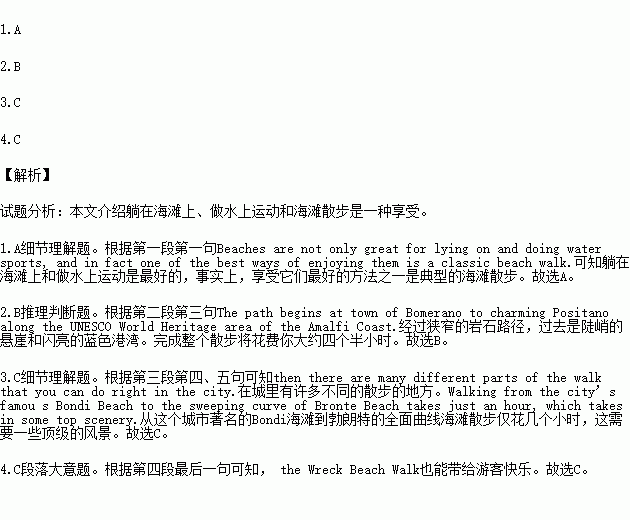题目内容
Beaches are not only great for lying on and doing water sports, and in fact one of the best ways of enjoying them is a classic beach walk. Here at iWantSun. Co. Uk, we’ve been searching the globe to find you the world’s best and most glorious beach walks, and here’s our pick of the top.
The Footpath of the Gods, Amalfi Coast, Italy
The name says it all really and you truly do feel up there to walking along this wonderful mountain coastal path, which offers some of the most striking views on the planet. The path begins at town of Bomerano to charming Positano along the UNESCO World Heritage area of the Amalfi Coast. The whole walk will take you approximately four and a half hours to complete and pass over narrow rocky paths, past sheer cliffs and shining blue bays.
Sydney’s Great Coastal Walk, Australia
Sydney’s coastline is one of the most beautiful and diverse in the world. Here you have national parks, historic sites, steep cliffs, sparkling beaches and quiet bays all in one place. Sydney’s Great Walk runs all the way from Barrenjoey in the north to Royal National Park in the south and takes an incredible seven days to complete. However, if you’re not up to doing the full walk, then there are many different parts of the walk that you can do right in the city. Walking from the city’s famous Bondi Beach to the sweeping curve of Bronte Beach takes just an hour, which takes in some top scenery.
Great Ocean Walk, Australia
The Great Ocean Walk stretches 104 km along Victoria’s famous Great Ocean Road, located on the southern coast of Australia, from the resort town Apollo Bay to the magnificent Twelve Apostles. The Twelve Apostles are the area’s famous stone landmarks which stand out like giants from the sea. The walk passes through a range of landscapes and sights, from national parks, famous surfing spots and deserted beaches, to wild coastlines, cascading waterfalls, lush forests, historic lighthouses and ghostly shipwrecks. Day walks and shorter three-hour walks such as the Wreck Beach Walk or the Lighthouse Cemetery and Lookout Walk can also be enjoyed.
So next time when you’re looking for a beach holiday don’t just think about the resorts and the sand, but consider a more active sun holiday, discovering some of the best beaches in the world.
1.The author intends to tell us ____________.
A. the world’s best places for beach walks
B. the wonderful beaches in the world
C. the ideal tourism resort for health
D. the beautiful beaches in Australia
2.When you arrive at the Amalfi Coast _______________.
A. you must be disappointed at the footpath
B. you will be fascinated by the scenery
C. you can start walking from Positano
D. you may be trapped in narrow rocky paths
3.What is special about Sydney’s Great Coastal Walk?
A. It takes about more than five hours to complete.
B. It starts from Royal National Park in the north.
C. It provides visitors a variety of great landscapes.
D. It really has the longest coastline in the world.
4.According to the fourth paragraph we can know that __________________.
A. Apollo Bay is at the end of the Great Ocean Walk
B. the Twelve Apostles exists below the surface of the sea
C. the Wreck Beach Walk can also give visitors pleasure
D. most visitors can finish the 104 km walk in three hours
 A加金题 系列答案
A加金题 系列答案 全优测试卷系列答案
全优测试卷系列答案
